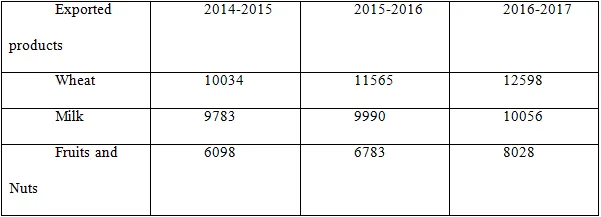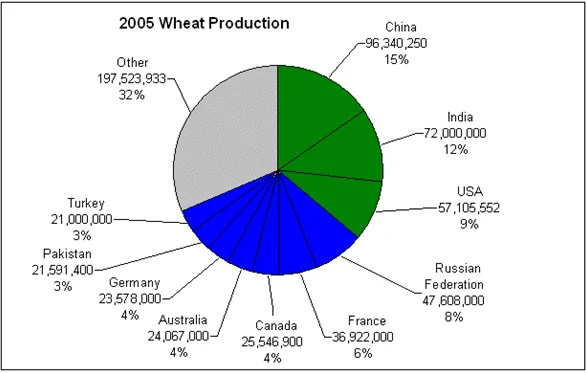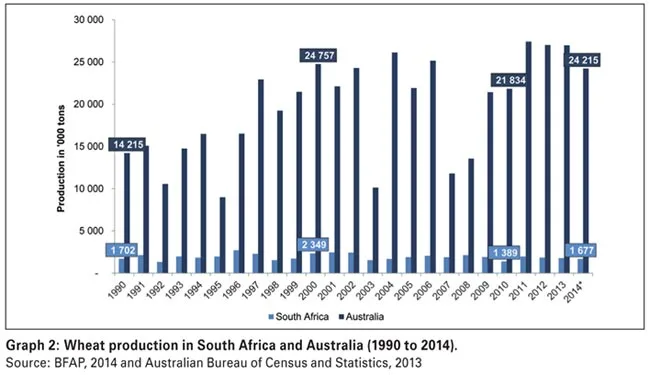The export market has proved to be a convenient bazaar for many countries in the world to see their products. Australia, which has tremendously invested in the agricultural sector, is a good example of a country that has embraced the export market by selling its products to foreign countries. An enormous number of labourers have been employed in the agricultural sector, making the country a major producer and exporter of agricultural products. Statistics show that Australia mostly gets its revenue from agricultural businesses, which results in a more stable economy.
Wheat is a top agricultural export product from Australia. According to the Australian Bureau of Agriculture and Resource Economics and Science (ABARES), wheat produces an average of 12.5% of all other exported agricultural products in Australia (Yasin, 2015, p. 132). Wheat is grown in both small-scale and large-scale farms, thus making the product more adequate and boosting its sales in the global market. Depicted below is an analytical study of an agricultural product that is widely exported from Australia.
The diagram below helps us to visualize how the wheat product in Australia has enormously and actively been involved in the export market (Yasin, 2015, p. 162).
As the above table portrays, wheat products are exported mainly from Australia, where over 16 million tons were shipped in 2016. Wheat is a winter crop that sows in autumn and is then harvested in summer and spring. Some of the primary states that produce wheat are New South Wales, Western Australia, north Australia, and Victoria.
Western Australia is essentially the major state that exports wheat overseas. Major potential foreign markets for wheat include Indonesia, South Korea, Japan, Malaysia and Sudan. Australia produces approximately 50% of its wheat in the export market, thus generating $2-3 billion each year. The country is well known for producing high-quality white wheat that is mostly grown in Western Australia and produces bright white flour with a high milling yield. As indicated above, Indonesia is the largest wheat market in Western Australia since the quality of wheat is high (Malcolm, 2015, p. 143).
Australian wheat quality normally has low discolouration, low moisture content, and high bulk density. Some of the major milling grades produced in Australia are Australian Hard, which is used for bread and contains about 12% of proteins; Australian Standard white (ASW), which is used for steamed bread, flat bread, and extra; Australian Standard Noodle (ASN) which is mostly exported to Japan to make Japanese noodles (Malcolm, 2015, p. 187).
The demand for wheat farming is tremendously displaying a strong growth in the international market. The high demand for Australian wheat exports is boosting industrial revenue in the country (Malcolm, 2015, p. 143). With the increasing industry demand for the product brings about high sale yard prices, thus boosting the revenue growth in Australia. It is anticipated for revenue to grow by 2.0%, making up to $16.7 billion within a timespan of two years with the ongoing increasing sale yard prices.
From Australian wheat news, it was reported that the USDA experienced high domestic food prices for wheat from Eastern Australia, which contributed to wheat exportation from that region decreasing, and many export markets opted to export their wheat from Western Australia. This has affected regional economic stability, and the rate at which government revenue comes from wheat exportation has drastically abridged (Kirkegaard, Christen, & Krupinsky, 2016, p. 195). The Western Australian region has gained the upper hand in exporting up to 90% of its harvest in the international export market. As a result, 40% of Australian wheat is exported from Western Australia, thus creating an economic catastrophe since there is an unbalanced marketing price of the commodity.
Another newspaper article, this time from the Arkansas Democratic Gazette, indicated a rise in wheat prices. The newspaper stated that wheat is a weed that feeds the human race, and the fact that it is grown on a large land more than any other crop in the world, it is experiencing price increment (Yasin, 2015, p. 87). After an analytical review of four straight white harvests, the rate at which the price is increasing is alarming to the exporting markets. Kansas and Eastern Australia are raising their wheat products, making it difficult for exporters to look for alternative countries to buy cheap wheat (Kirkegaard, Christen, & Krupinsky, 2016, p. 189).
Recommendations To The Key Player
The government ought to come up with a policy to facilitate an active and stable market for wheat farming and exportation. Some of the policies the government should implement are as follows: the government should demand a quality wheat product. A quality product attracts the buyer. Flour millers not only export wheat from Australia because it generates for the entire world, but they are more concerned with the quality of the product (Montfort, 2013, p. 173). Thus, the government should foresee that the wheat farmers produce quality products to be exported.
A balance sheet policy is another effective way that the government should implement to ensure that the pricing of wheat is controlled. Some wheat-producing states are increasing their wheat cost, which is resulting in some wheat-exporter countries withdrawing. Although the Western Australia region has tried to moderate their wheat pricing in the market, other states are triggering major wheat exporters to look for alternative markets (Montfort, 2013, p. 182). The Australian government should control product pricing to mitigate cases of countries withdrawing from the Australian wheat market (Wood, Lenzen, Dey, & Lundie, 2015, p. 315).
It is anticipated that in future, the growth of Australian government revenue will be improved from wheat exportation if only the key players implement policies to foresee and protect the wheat industry. As depicted above, it is clear that despite Australia having majored in many agricultural practices, wheat farming will remain the most used agricultural practice in exporting and consuming its products. The policy that the government will implement will safeguard both the cattle and cattle farmers, thus creating a conducive environment for cattle farming (Wood, Lenzen, Dey, & Lundie, 2015, p. 326).
Reference List
Einspruch. (2015). More than wheat. Port Melbourne: Barrie Publishers
Kirkegaard , J., Christen , O., & Krupinsky, J. (2016). Break crop benefits in temperate wheat production. Field Crops Research, 107(2), 180-198.
Malcolm, L. R. (2015). Agriculture in Australia. South Melbourne: Oxford University.
Montfort, W. (2013). Agriculture products in Australia (2nd ed.). Datamnitor: University of Western Australia.
Wood , R., Lenzen , M., Dey , C., & Lundie, S. (2015). A comparative study of some environmental impacts of conventional and organic farming in Australia. Agricultural systems, 89(2), 310-330.
Yasin, M. A. (2015). Economics of organic farming systems and policy options in Australia. Kansas: press.
Cite This Work
To export a reference to this article please select a referencing stye below:










